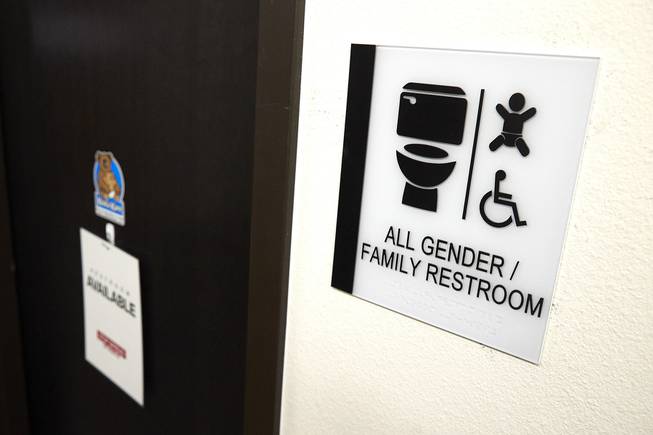
Josh Hawkins / UNLV Photo Services
All-gender restroom signage now appears on many single-use bathrooms through the UNLV campus.
Tuesday, June 15, 2021 | 2 a.m.
Jamie Sprague-Ballou’s heart raced in fear every time she walked into a public restroom when she was transitioning from male to female. In the women’s restroom, she risked being humiliated by security. In the men’s restroom, she risked violence.
“Nobody wants to walk into a restroom and get beat up because somebody doesn’t understand you,” said Sprague-Ballou, a UNLV student and founder of the nonprofit organization Las Vegas Transpride.
Sprague-Ballou was relieved to hear last week that UNLV changed signs for 165 of its single-use public restrooms at the Maryland Parkway and Shadow Lane campuses to say, “All-gender restrooms,” with a small symbol of a toilet.
“That’s a huge statement. ... That is inviting and welcoming to everybody. I don’t know how much more inclusive you could make the campus,” Sprague-Ballou said.
Gov. Steve Sisolak signed Assembly Bill 280 into law last week, requiring all single-stall bathrooms in public places throughout the state to be gender-neutral. The legislation passed the Nevada Assembly 36-5 with one vote excused, and the state Senate 15-6.
Almost every building at UNLV has a single-toilet, all-gender restroom. Multi-stall restrooms are still separated by male or female signage.
The former signs on single-toilet restrooms on campus just said, “Restroom.” Some had a male and female symbol or just a symbol of a toilet.
“Giving everybody the sense of belonging and feeling welcome, comfortable and safe, that comes up a lot. People just want a place where they feel safe,” said John Treston, director of design and associate architect with UNLV’s planning and construction team.
Sprague-Ballou said many transgender people who are transitioning fear someone will spy on them while they are in a bathroom stall. “They want to humiliate the person, and that’s the sad part about it,” she said.
There’s also the worry over being questioned about using the proper bathroom.
In the early-2000s, when Sprague-Ballou was transitioning, she said security personnel at a local casino followed her into the women’s restroom and asked for her identification. By that time, she had already changed her gender on her ID.
“It’s a nightmare still in some parts. Our state’s pretty good, but we still have incidents,” said Sprague-Ballou, who has fully transitioned. “There are other states where it’s scary to be LGBTQ altogether. We live in a pretty good state where we have laws to protect us; some states don’t.”
When the Safety and Security Working Group was founded in 2019, it looked at issues affecting the well-being of students, and all-gender restrooms quickly rose to the top of the list of priorities.
Before the project, there were only 13 all-gender restrooms.
The committee also decided to add baby-changing stations to many of the all-gender restrooms to enhance the availability for those with small children. In total, 129 of the single bathrooms — one toilet; one sink — have a changing station.
“We know that the benefits of all-gender restrooms run deeper than providing safety for trans and nonbinary individuals,” said Barbee Oakes, UNLV’s retiring as chief diversity officer, in a news release. “Achieving this goal also has the potential to fundamentally transform the way that we think about gender equity; and signals that UNLV is striving to provide an equitable, inclusive campus for everyone.”
The university designed the all-gender restroom signs in-house with guidance from the committee. The signs cost $61 to $67 each.
The signs were delivered in March last year when the coronavirus pandemic began, so they sat packaged for a few months before Treston and his team began installing them in the summer.
“It was like, ‘That didn’t take too much effort.’ It was like, ‘Why didn’t we do this before?’ ” Treston said.
